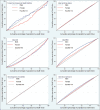Metrics of Ideal Cardiovascular Health are Unequally Distributed between Peruvian Men and Women: Analysis of a National Population-Based Survey in 2017
- PMID: 33815714
- PMCID: PMC8000168
- DOI: 10.4103/ijpvm.IJPVM_326_19
Metrics of Ideal Cardiovascular Health are Unequally Distributed between Peruvian Men and Women: Analysis of a National Population-Based Survey in 2017
Abstract
Background: To determine socioeconomic inequalities in cardiovascular health (CVH) metrics among Peruvian adults as well as differences according to sex.
Methods: An observational, cross-sectional study was conducted in 26,175 individuals aged 18-65 years using the 2017 Peruvian Demographic and Health Survey. According to the American Heart Association, 5 CVH metrics which comprised three ideal health behaviors (diet, non smoking, ideal body mass index [BMI]), and two ideal health factors (ideal blood pressure and no history of diabetes) were evaluated. The concentration curves (CC) methodology was used to analyze whether CVH metrics vary between socioeconomic status and sex. The concentration index (CI) was used to quantify socioeconomic-related inequality in health variables.
Results: Overall, the mean age was 36.5 years (SD = 11.9) and 51.2% were women. Only 2.4% had 5 ideal CVH metrics (women 3.7%, men 1.0%) with a CI very close to the equality line (0.0135). (0.0135; higher in women [0.0262], compared to men [0,0002]). A greater prevalence of ideal CHV metrics (3 or more) was found in women (P < 0.001). Ideal health factors were more prevalent (52.1%) than ideal health behaviors (13.8%). Regarding inequality measures, CCs for most CVH metrics had a higher concentration in the lowest wealth population, except for ideal diet, which was more frequent among higher levels of wealth. An ideal BMI was the CVH metric with the lowest CI (overall: -0.0817; men: -0.2699).
Conclusions: Peruvian women presented a higher prevalence of ideal CVH metrics and fewer inequalities. Ideal CVH metrics tend to be concentrated in the wealthiest women. Low- and middle-income countries should consider socioeconomic inequalities in cardiovascular disease prevention programs.
Keywords: Cardiovascular health; Latin America; Peru; Sex; health surveys; inequalities.
Copyright: © 2019 International Journal of Preventive Medicine.
Conflict of interest statement
There are no conflicts of interest.
Figures
Similar articles
-
Sex inequalities in cardiovascular health: a cross-sectional study.Eur J Public Health. 2016 Feb;26(1):152-8. doi: 10.1093/eurpub/ckv161. Epub 2015 Sep 14. Eur J Public Health. 2016. PMID: 26370435
-
Status of cardiovascular health in the Republic of Serbia: Results from the National Health Survey.PLoS One. 2019 Mar 27;14(3):e0214505. doi: 10.1371/journal.pone.0214505. eCollection 2019. PLoS One. 2019. PMID: 30917180 Free PMC article.
-
The association of ideal cardiovascular health and left ventricle hypertrophy in rural population of northeast China: A cross-sectional observational study.Medicine (Baltimore). 2017 Feb;96(6):e6050. doi: 10.1097/MD.0000000000006050. Medicine (Baltimore). 2017. PMID: 28178152 Free PMC article.
-
Demographic and socioeconomic inequalities in ideal cardiovascular health: A systematic review and meta-analysis.PLoS One. 2021 Aug 11;16(8):e0255959. doi: 10.1371/journal.pone.0255959. eCollection 2021. PLoS One. 2021. PMID: 34379696 Free PMC article.
-
Prevalence of the cardiovascular health status in adults: A systematic review and meta-analysis.Nutr Metab Cardiovasc Dis. 2018 Dec;28(12):1197-1207. doi: 10.1016/j.numecd.2018.08.002. Epub 2018 Aug 20. Nutr Metab Cardiovasc Dis. 2018. PMID: 30360955
Cited by
-
Socio-economic inequalities in the consumption of fruits and vegetables in Peru between 2014 and 2019.Public Health Nutr. 2022 Sep 8;25(12):1-11. doi: 10.1017/S1368980022001860. Online ahead of print. Public Health Nutr. 2022. PMID: 36073028 Free PMC article.
-
Reactive Hyperemia-Triggered Wrist Pulse Analysis for Early Monitoring of Young Men with High Atherosclerotic Risk.Diagnostics (Basel). 2021 Oct 16;11(10):1918. doi: 10.3390/diagnostics11101918. Diagnostics (Basel). 2021. PMID: 34679616 Free PMC article.
-
Study protocol of the PEruvian Registry of ST-segment Elevation Myocardial Infarction II (PERSTEMI-II) study.PLoS One. 2021 Sep 17;16(9):e0257618. doi: 10.1371/journal.pone.0257618. eCollection 2021. PLoS One. 2021. PMID: 34534262 Free PMC article.
References
-
- WHO | Cardiovascular diseases (CVDs) [[Last accessed on 2019 May 19]]. Published Online First: 17 May 2019. Available from: https://wwwwhoint/cardiovascular_diseases/en/
-
- Lloyd-Jones D, Adams R, Carnethon M, De Simone G, Ferguson TB, Flegal K, et al. Heart disease and stroke statistics--2009 update: A report from the American heart association statistics committee and stroke statistics subcommittee. Circulation. 2009;119:e21–181. - PubMed
-
- Ford ES, Ajani UA, Croft JB, Critchley JA, Labarthe DR, Kottke TE, et al. Explaining the decrease in U.S deaths from coronary disease, 1980-2000. N Engl J Med. 2007;356:2388–98. - PubMed
-
- Lloyd-Jones DM, Hong Y, Labarthe D, Mozaffarian D, Appel LJ, Van Horn L, et al. Defining and setting national goals for cardiovascular health promotion and disease reduction: The American heart association's strategic impact goal through 2020 and beyond. Circulation. 2010;121:586–613. - PubMed
LinkOut - more resources
Full Text Sources

